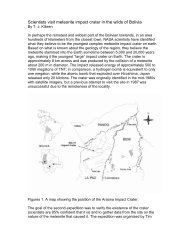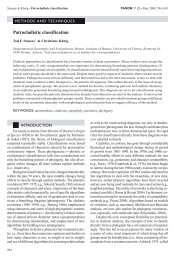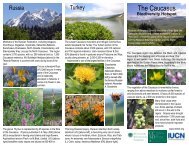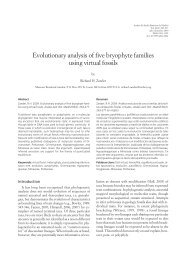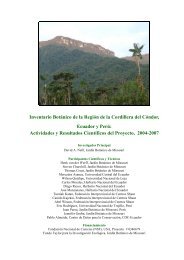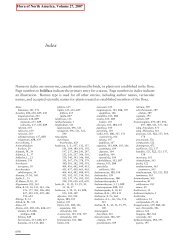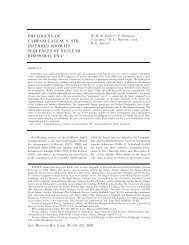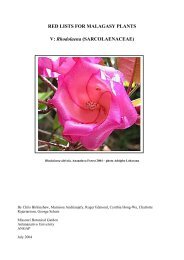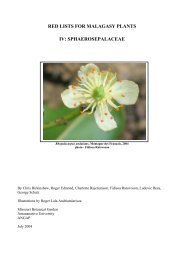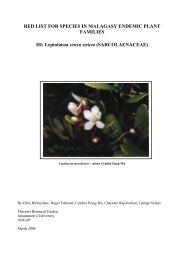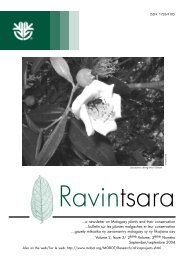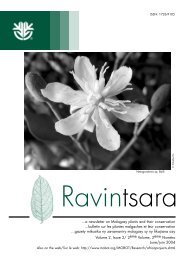re-evaluation of tortella - Missouri Botanical Garden
re-evaluation of tortella - Missouri Botanical Garden
re-evaluation of tortella - Missouri Botanical Garden
You also want an ePaper? Increase the reach of your titles
YUMPU automatically turns print PDFs into web optimized ePapers that Google loves.
shifting but widesp<strong>re</strong>ad distribution <strong>of</strong> alluvial deposits<br />
north <strong>of</strong> or at the border <strong>of</strong> glaciation, and T. rigens with<br />
the alvar substrates c<strong>re</strong>ated by scouring water<br />
terminated suddenly (perhaps by st<strong>re</strong>am captu<strong>re</strong> in the<br />
scenario <strong>of</strong> <strong>re</strong>t<strong>re</strong>ating continental glaciers) so that their<br />
4<br />
beds become suba<strong>re</strong>al with little or no sedimentary<br />
deposition.<br />
Herbarium codes a<strong>re</strong> according to Holmg<strong>re</strong>n et<br />
al. (1990).<br />
KEY TO THE SPECIES OF TORTELLA IN NORTH AMERICA NORTH OF MEXICO<br />
1. Leaves oblong-lanceolate or elliptical, apex broadly acute to obtuse, sometimes cucullate . . . . 2<br />
2. Autoicous, nearly always fruiting; distal margins plane to e<strong>re</strong>ct, apex broadly acute; distal leaf cells<br />
about 6–7 µm; central strand p<strong>re</strong>sent; cells on adaxial surface <strong>of</strong> the costa quadrate and papillose<br />
throughout most <strong>of</strong> its length; stems short; plants typically rosulate, densely foliose, widesp<strong>re</strong>ad in the East,<br />
ra<strong>re</strong> in the West . . . . 1. Tortella humilis<br />
2. Dioicous, seldom fruiting; distal margins incurved to strongly or variably cucullate at the apex, apex<br />
obtuse; distal leaf cells 7–11(–14) µm in diameter; central strand p<strong>re</strong>sent or absent; cells on adaxial surface<br />
<strong>of</strong> the costa quadrate and papillose throughout most <strong>of</strong> their length or mostly or enti<strong>re</strong>ly elongate and<br />
smooth; stems elongate; plants loosely foliose . . . . 3<br />
3. Stem central strand p<strong>re</strong>sent; costa with adaxial epidermis: a<strong>re</strong>as on the adaxial surface <strong>of</strong> the<br />
costa with quadrate papillose cells; leaf apex variably somewhat cucullate, acute or obtuse with<br />
apical margins incurved; leaves flat in the leaf middle; fertilized perichaetial leaves not much<br />
diffe<strong>re</strong>ntiated, mosses <strong>of</strong> the coast <strong>of</strong> southeastern United States or Europe . . . . 4<br />
4. Leaves not fragile, apices <strong>of</strong> all leaves p<strong>re</strong>sent; nearly always some leaf apices<br />
cucullate or subcucullate; distal laminal cells 10–12 µm wide; proximal cells abruptly<br />
diffe<strong>re</strong>ntiated at least in larger leaves, thin-walled proximal cell <strong>re</strong>gion extending up the<br />
margin into the limb; radicles sparse, confined to the stem base; guide cells never with<br />
bistratose pairs; mosses exclusively <strong>of</strong> coastal North Carolina south to Florida and west<br />
to Texas . . . . 2. Tortella flavovi<strong>re</strong>ns<br />
4. Leaves fragile, apices <strong>of</strong> nearly all leaves absent; leaf apices inf<strong>re</strong>quently subcucullate,<br />
sometimes distal margin incurved; distal laminal cells 6–10 µm wide; cells gradually<br />
diffe<strong>re</strong>ntiated and thick-walled in the proximal cell <strong>re</strong>gion in all leaves, except for a<br />
narrow marginal border <strong>of</strong> thin-walled cells extending up the margin a short way into the<br />
limb; tomentose in proximal stem <strong>re</strong>gion; guide cells occasionally with bistratose pairs;<br />
plants <strong>of</strong> Europe only . . . . 8. Tortella nitida<br />
3. Stem central strand absent; costa without adaxial epidermis: adaxial surface <strong>of</strong> the costa with<br />
smooth, elongate cells throughout the leaf length; leaf apex distinctly cucullate, occasionally<br />
acute, leaves tubulose; fertilized perichaetial leaves conspicuously diffe<strong>re</strong>ntiated, with subulate<br />
tips; mosses <strong>of</strong> the G<strong>re</strong>at Lakes <strong>re</strong>gion and north . . . . 5<br />
5. Leaf cells 11–12 µm or less, stems orange to g<strong>re</strong>enish yellow-brown, leaves deep<br />
yellow or orange in KOH; leaves ir<strong>re</strong>gularly or uniformly twisted on the stem; leaf apices<br />
usually cucullate to narrowly acute, not deciduous; leaves in section usually keeled at the<br />
costa, margins incurved; in rock c<strong>re</strong>vices or unconsolidated alluvial sediments near water<br />
. . . . 6. Tortella inclinata<br />
5. Leaf cells averaging 14 µm; stems dark-g<strong>re</strong>en to brown, leaves g<strong>re</strong>en in KOH; leaves<br />
e<strong>re</strong>ct, twisted only at the stem tips; leaf apices variable, usually acute to acuminate, never<br />
uniformly cucullate, f<strong>re</strong>quently with a narrowed apical deciduous point; leaves in section<br />
broadly tubulose; mosses <strong>of</strong> limestone pavements with thin soil cover (alvar) in the G<strong>re</strong>at<br />
Lakes <strong>re</strong>gion . . . . 7. Tortella rigens<br />
1. Leaves narrowly short to long- to linear-lanceolate, not cucullate or obtuse, apex narrowly acute, tapering to an<br />
acuminate point, sometimes apex very long, with a long, setaceous point . . . . 6<br />
6. Leaves without apical propaguloid modifications although some apices may be somewhat fragile . . . . 7<br />
7. Stems with central strand, leaf cells ca. 14 µm . . . . 3. Tortella alpicola<br />
7. Stems without central strand, or this ra<strong>re</strong>, leaf cells to 14 µm but <strong>of</strong>ten less . . . . 8<br />
8. Leaves tubulose, margins broadly incurved; most distal laminal cells 14 µm; quadrate,<br />
papillose adaxial cells on the surface <strong>of</strong> the costa absent throughout the leaf length to a<br />
width <strong>of</strong> two or th<strong>re</strong>e cells in section; leaf apices deciduous; known from limestone<br />
pavements in the G<strong>re</strong>at Lakes <strong>re</strong>gion . . . . 7. Tortella rigens<br />
8. Leaves plane to canaliculate, margins plane to e<strong>re</strong>ct; distal laminal cells seldom<br />
attaining 12 µm, usually less; quadrate, papillose adaxial cells on the surface <strong>of</strong> the costa<br />
p<strong>re</strong>sent in the median leaf <strong>re</strong>gion or higher; <strong>of</strong> general temperate to Arctic distribution . .<br />
. . 4. Tortella tortuosa





